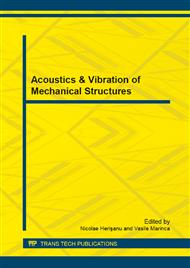p.276
p.281
p.285
p.290
p.297
p.305
p.312
p.317
p.323
Troubleshooting Technics to Identify the Airborne and Structure-Borne Noise Content inside an Electric Vehicle
Abstract:
An electric vehicle was subjected to on-road acoustic tests. A specific high frequency tone was perceived in a sound field dominated by wind and road noise. The car was instrumented with microphones which measured the noise inside the passenger compartment and with tachometers to record the motors rotational velocity with respect to time. Waterfall diagrams were generated by tracking the spectrums of noise from fixed time samples against the rpm of the motor. The analysis of the diagrams revealed that high orders, like the 24th and 48th were responsible for the sound. These orders represent the acoustic response of the electromagnetic interaction between the stator and the rotor of the electric motor. To analyze the propagation of noise from the source (motor) to the target (driver), a transfer path analysis (TPA), respectively an airborne source quantification (ASQ) were proposed. The TPA focused on the structure borne noise generated by the forces transmitted into the body through the powertrain supports, and the ASQ, on the airborne noise radiated by the surface of the motor and gearbox casing. The conclusion was that the airborne noise is the main contributor to the total pressure level in the passenger compartment, but at lower speeds a strong structure borne noise content is present.
Info:
Periodical:
Pages:
297-302
Citation:
Online since:
September 2013
Authors:
Price:
Сopyright:
© 2013 Trans Tech Publications Ltd. All Rights Reserved
Share:
Citation:


